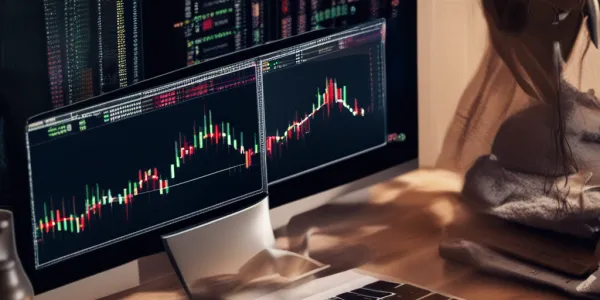Margin
Margin
Understanding 'Margin' in Cryptocurrency Option Trading
Cryptocurrency trading comes with its unique set of terms and terminologies, and one such crucial term is "Margin". Margin can be a bit complicated to grasp, especially for beginners, but once you familiarize yourself with it, you'll come to see it as a practical tool that can considerably expand your trading capabilities.
Margin - A Simple Definition
In financial terms, a Margin is a loan provided by your broker that allows you to leverage your investment to trade larger amounts of an asset - in this case, cryptocurrencies. This way, by trading 'on Margin', you can open positions that are considerably larger than the balance of your personal account. However, it's important to understand that trading on Margin also amplifies the potential for both profits and losses.
How Does Margin Trading in Cryptocurrencies Work?
When engaging in cryptocurrency option trading, investors can employ Margin to increase their buying power. This is expressly beneficial in situations where a trader anticipates a certain pricing move. After determining an expected move, they could then open a larger position using Margin, hence standing to gain more if their prediction is correct. Nonetheless, a wrong prediction can lead to larger losses, as with greater rewards comes greater risk.
Risks and Responsibilities with Margin Trading
Trading on Margin is a double-edged sword. While the potential for high profits can be appealing, the possibility of higher losses is equally real. Traders must be vigilant when using Margin and understand that it is essentially borrowed money. Failure to maintain an adequate balance can lead to a 'Margin call,' wherein the broker requests additional funds to cover potential losses. At times, if the amount is not immediately available, positions could be closed forcefully to mitigate the risk.
Conclusion
Ultimately, Margin in cryptocurrency option trading is a tool that can expand a trader's possibilities significantly. Through careful use and thorough understanding, traders can amplify their buying power and potential profits. However, the inherent risks must be factored in and prepared for, ensuring its use does not lead to damaging losses. Undertake Margin trading responsibly to profit maximally from your cryptocurrency option trading endeavors!
Blog Posts with the term: Margin

This article simplifies the basics of crypto options trading, explaining key concepts like call and put options, strike prices, and expiration dates. It highlights the advantages such as leverage, risk management, flexibility, cost-effectiveness, and profitability in various market conditions while...

The article explains the differences between bitcoin options and futures, highlighting that while both are used for hedging and speculation in cryptocurrency markets, they differ significantly in terms of contractual obligations, risk exposure, profit potential, upfront costs, and market liquidity....

Option trading with a budget of $1000 is feasible and can yield significant returns if managed strategically, focusing on low-premium contracts to maximize leverage while minimizing risk. Understanding options—contracts that offer the right to buy or sell an asset at...

Option trading is a complex field that involves contracts granting the right to buy or sell an asset, with call and put options being the two main types. Traders must understand market quotes, option values, strategies, risk management, and use...

Option trading involves contracts that allow buying or selling an asset at a set price before a certain date, with call and put options being the two main types. These derivatives are influenced by factors like current asset price and...

Deribit is a leading platform for Bitcoin options trading, offering deep liquidity, advanced analytics, and robust tools like the Option Wizard to cater to both novice and expert traders. Its focus on security, innovation, and user-friendly features makes it a...

Option trading on Angel One offers a range of financial instruments, including call and put options, with features like American and European settlement styles; the platform provides resources for beginners. Traders can choose from various types of options such as...

This article serves as a beginner's guide to understanding options trading within the world of cryptocurrencies. It covers the basics of options trading, the types of crypto options, where to trade them, the pros and cons of crypto options trading,...

Bybit’s crypto options platform offers a user-friendly, feature-rich environment for both beginners and pros to trade European-style contracts with robust liquidity. Setting up an account is straightforward, and the intuitive interface makes navigating option chains, placing trades, and managing risk...

Deribit is a leading crypto options trading platform specializing in Bitcoin and Ethereum derivatives, offering advanced tools, low-latency execution, deep liquidity, and user-friendly features for both novice and professional traders. Its robust technology, portfolio margining system, real-time analytics, and 24/7...

Option trading charges are fees incurred when buying or selling options, including commission, regulatory, exchange, clearing, and miscellaneous fees. Understanding these costs is crucial for traders to manage finances effectively and strategize to minimize expenses while maximizing potential profits....

The article compares crypto trading and options trading, highlighting their unique opportunities, risks, and key differences such as market hours, volatility management, leverage mechanisms, risk management tools, and regulatory environments. It aims to help readers understand each method's characteristics to...

Option trading and future trading are two distinct financial instruments for portfolio diversification, with options providing the right to trade without obligation and futures requiring a binding agreement. Options involve lower initial investment but limited risk exposure, while futures have...

The article provides a comprehensive guide to Ethereum options trading, explaining what options are, how they can be used for speculation and hedging, and detailing the steps to buy them on platforms like Bybit, Deribit, and Bit.com. It also highlights...
